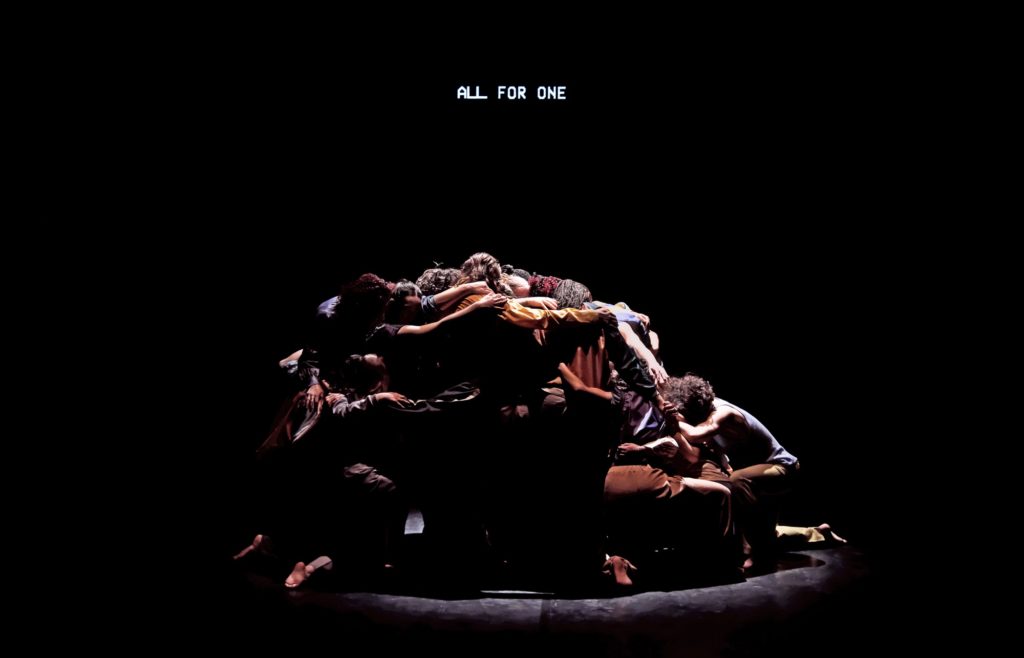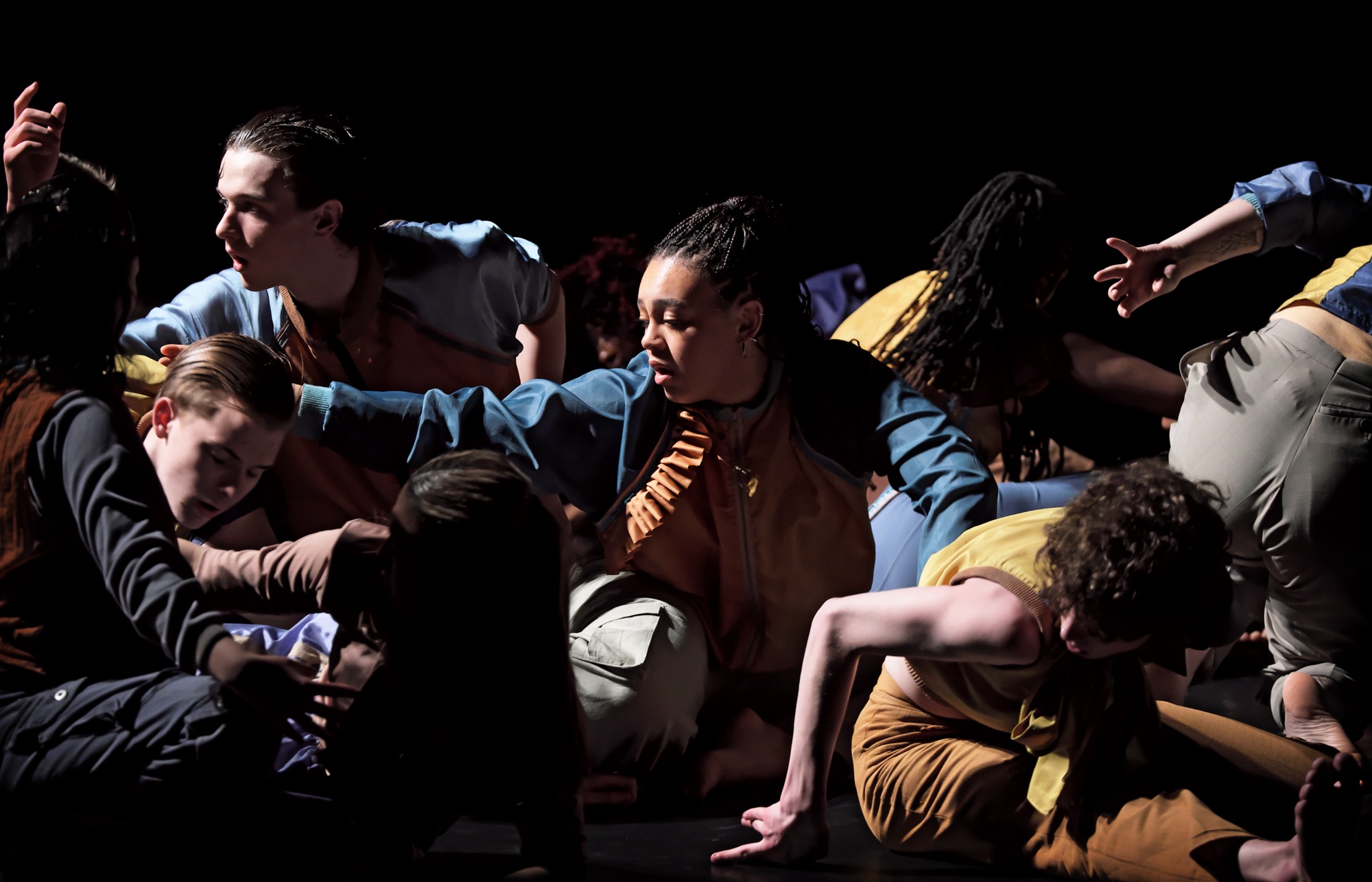Words by Hannah Finnimore.
“All for one
And one for all
You hear the call
Your country needs you
To play football”
More tender, patient and thoughtful than the title suggests, Oona Doherty’s Wall (performed by the brilliant NYDC) is a meditation on home and belonging in an England hypnotised by nostalgia.
Opening on a half-lit stage, a spotlight crawls along, highlighting four gently undulating and grounded piles of young dancers. They sway slowly, seaweed-like, garbed in personalised-pedestrian costumes of yellow, orange and blue, designed by Ryan Dawson Laight. Faces soft, eyes closed, the dancers look like dreamers.
Above them, a screen flashes snippets of a rhyme, repeating phrases, introducing new voices in an Orwellian font and a Big Brother sound (composed by Mark Leckey with Luca Truffarelli and Shamos).
This sets the stage for the conflicting ideas of Wall – the cold distorted presence of the screen and recorded spoken word score, overlooking the organic, gentle, waves of interconnected movement. Surveillance and instruction versus the unselfconscious, easy hopeful presence of the young.
Gradually, the dancers begin to rise, but this is not a protest – each time a figure emerges they are gently reabsorbed back into the collective. This feels like a protective gesture, not a sinister one, and again reinforces this sense of an aquatic environment, with lots of colourful activity creating ripples on the surface.
The dystopian themes reemerge with spoken word ‘score’ and on screen references to war and conquest (“Your country needs you”) and the company recreating a shape reminiscent of a rule Britannia procession. The dancers are trying to fit themselves into an image of England, and it’s chilling to witness.
But the dread dissipates quickly, as we step into different times, places and perspectives, led by snippets of interviews from the dancers themselves and older participants. We hear about their anxieties, carefree moments and small rebellions.
Briefly referencing a parentally-sabotaged sneak-out to a Beatles gig through a recorded interviewee’s anecdote, Doherty taps into the 1960’s invention of a new social category – the teenager. It is a shame then, that there is less evidence of the vivacity, rage and confusion of that age group in the movement language and the expressions of the dancers, with a consistent return to gentle, rolling floor work as a group.
With this focus on a slow-motion-collective, instead Doherty has seemingly centred mutual support in her work. In a striking sequence, all but two of the company are lined up at the back of the stage as dancer Francis rolls upstage left. He seems to be pulled there by the tractor beam of the company’s group gaze – a look of open curiosity that culminates in his acceptance into that line.
Gaze is then thrown back at the audience as dancer Ayuna pulls herself centre stage, performing her solo with light and happy defiance and mirroring Francis, is easily accepted by the group. The intimacy of the company is evident and pleasant to watch, but the audience is kept at arm’s length by a persistent tone of restraint.
There are two moments that very nearly break through that tone. Half the company begins to fall to the ground in perfect repeated unison, edging closer with each fall to the audience as the other half of dancers at the back of the stage fold into waving grounded swells of motion that typify the piece.
The score fades out and we can hear the rhythmic breathing of these half exhausted young dancers, throwing themselves at our feet, again and again, finally laying down, to be gathered up one by one, by their cohort. It hints at coming-of-age as a process of trying and failing, but doesn’t last long enough to be more than a fleeting highlight.
There is another bold moment of audience connection – a joyful and free-flowing solo by Luke. There is a sense of flair and abandon, confident Vogueing and some jaw-dropping dips made even more stunning by some well timed strobe lighting (thank you John Gunning).
The sense of maturity in the piece is impressive for the age of the dancers (NYDC dancers are aged between 16 – 24), but I wonder if there was a missed opportunity to tap into the hunger of youth and the visible talent of this company and leave it all on the dance floor. The impression left by the end is that the audience is still in the nightclub queue and something more fun is happening in the gig around the corner. Then again, perhaps in that Doherty has captured something of the quintessential teenage experience in England.

Wall premiered on Saturday 13 April at Leeds Playhouse, and will tour around the UK to Wakefield, Falmouth, Ipswich, Latitude Festival, Leicester and London, including a performance at Sadler’s Wells Theatre on Saturday 13 July.
Full tour dates:
Wakefield
CAPA College
Sunday 30 June at 7 pm
Falmouth
AMATA Arts Centre, Falmouth University
Sunday 7 July at 7:30 pm
London
Sadler’s Wells
Saturday 13 July at 7:30 pm
Ipswich
DanceEast
Saturday 20 July at 7:30 pm
London
Bold Tendencies
Thursday 25 July at 8 pm
Suffolk
Latitude Festival
Saturday 27 July
Leicester
The Curve
Monday 29 July at 7:30 pm
